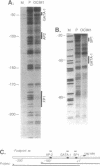Abstract
Erythropoietin (Epo), the primary regulator of the production of erythroid cells, acts by binding to a cell surface receptor (EpoR) on erythroid progenitors. We used deletion analysis and transfection assays with reporter gene constructs to examine the transcription control elements in the 5' flanking region of the human EpoR gene. In erythroid cells most of the transcription activity was contained in a 150 bp promoter fragment with binding sites for transcription factors AP2, Sp1 and the erythroid-specific GATA-1. The 150 bp hEpoR promoter exhibited high and low activity in erythroid OCIM1 and K562 cells, respectively, reflecting the high and low levels of constitutive hEpoR expression. The GATA-1 and Sp1 binding sites in this promoter lacking a TATA sequence were necessary for a high level of transcription activation. Protein-DNA binding studies suggested that Sp1 and two other CCGCCC binding proteins from erythroid and non-erythroid cells could bind to the Sp1 binding motif. By increasing GATA-1 levels via co-transfection, we were able to transactivate the hEpoR promoter in K562 cells and non-erythroid cells, but not in the highly active OCIM1 cells, although GATA-1 mRNA levels were comparable in OCIM1 and K562. Interestingly, when we mutated the Sp1 site, resulting in a marked decrease in hEpoR promoter activity, we could restore transactivation by increasing GATA-1 levels in OCIM1 cells. These data suggest that while GATA-1 can transactivate the EpoR promoter, the level of hEpoR gene expression does not depend on GATA-1 alone. Rather, hEpoR transcription activity depends on coordination between Sp1 and GATA-1 with other cell-specific factors, including possibly other Sp1-like binding proteins, to provide high level, tissue-specific expression.
Full text
PDF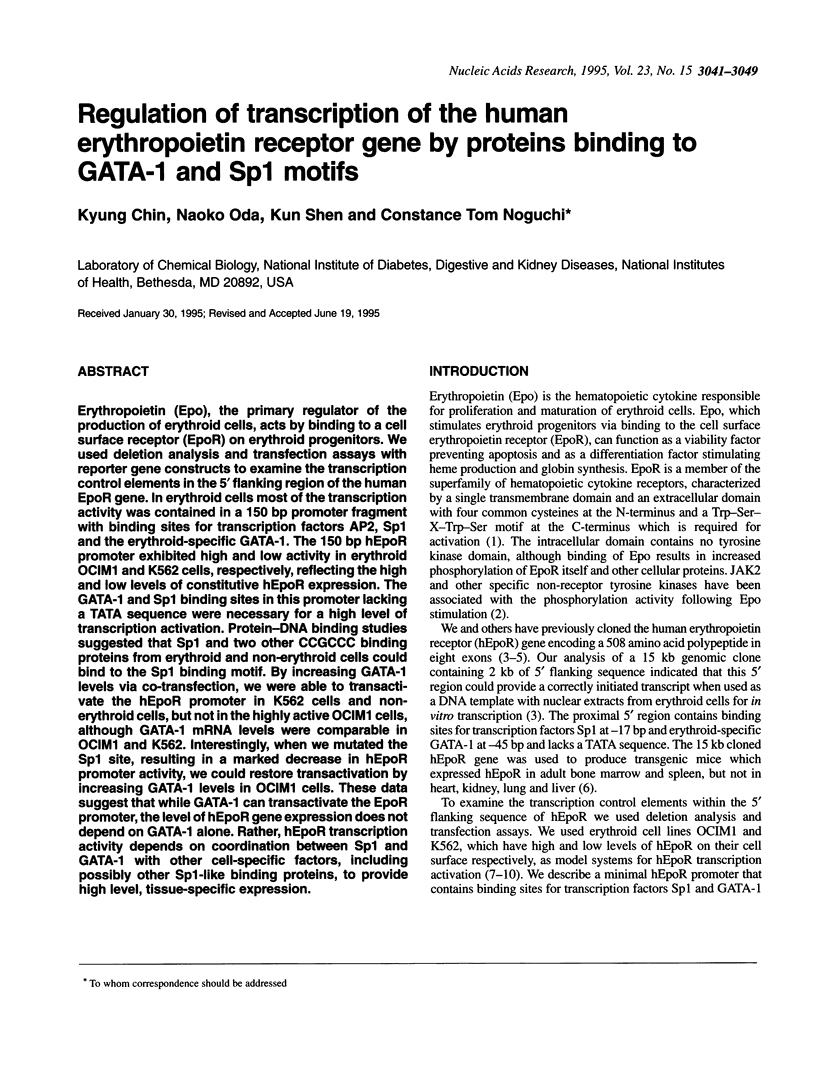
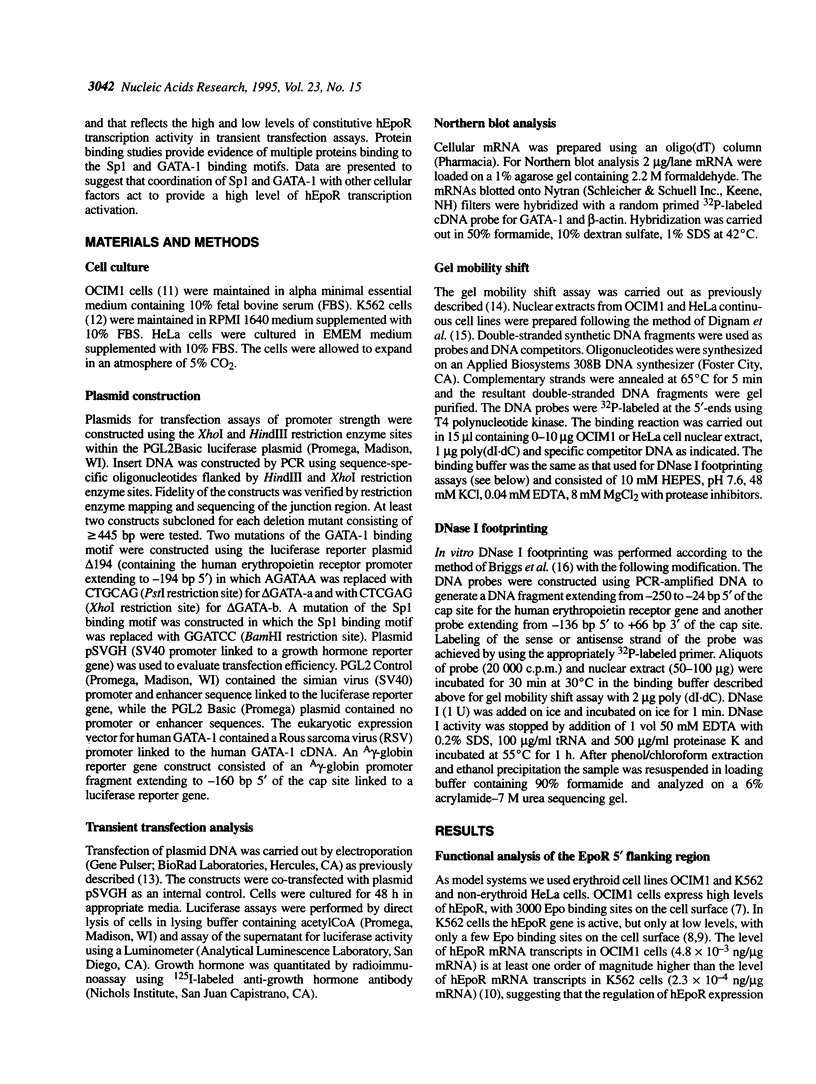
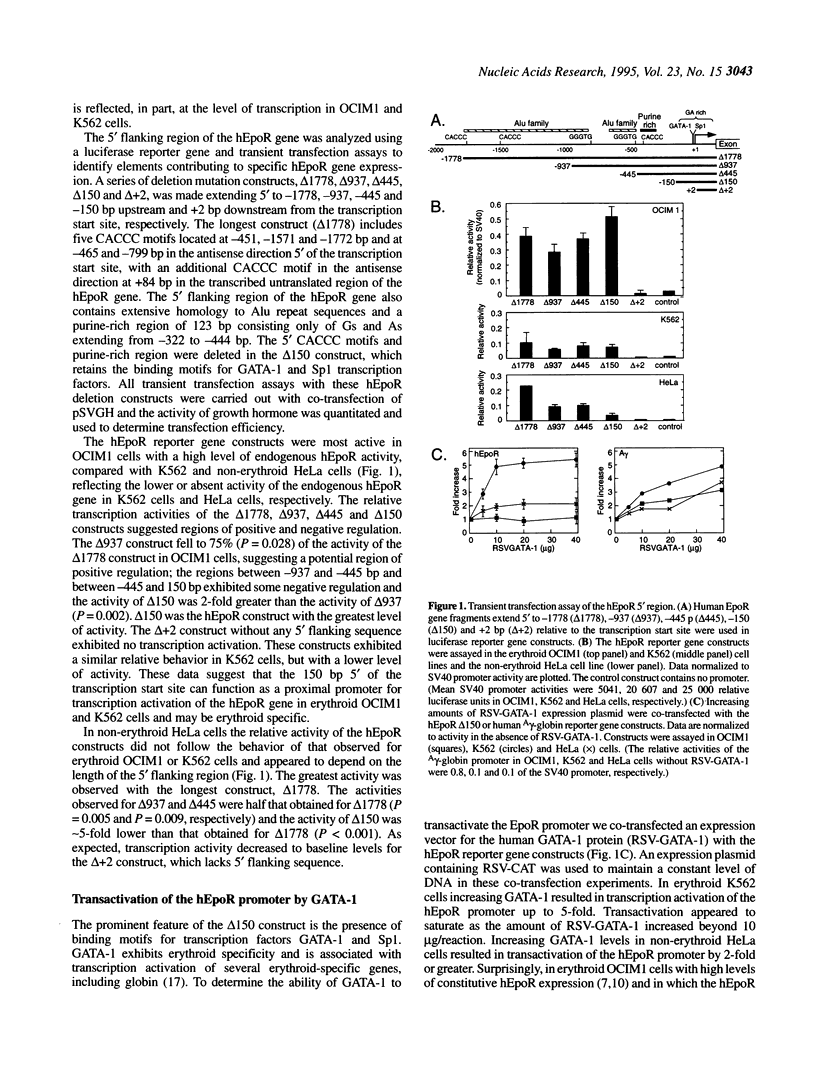
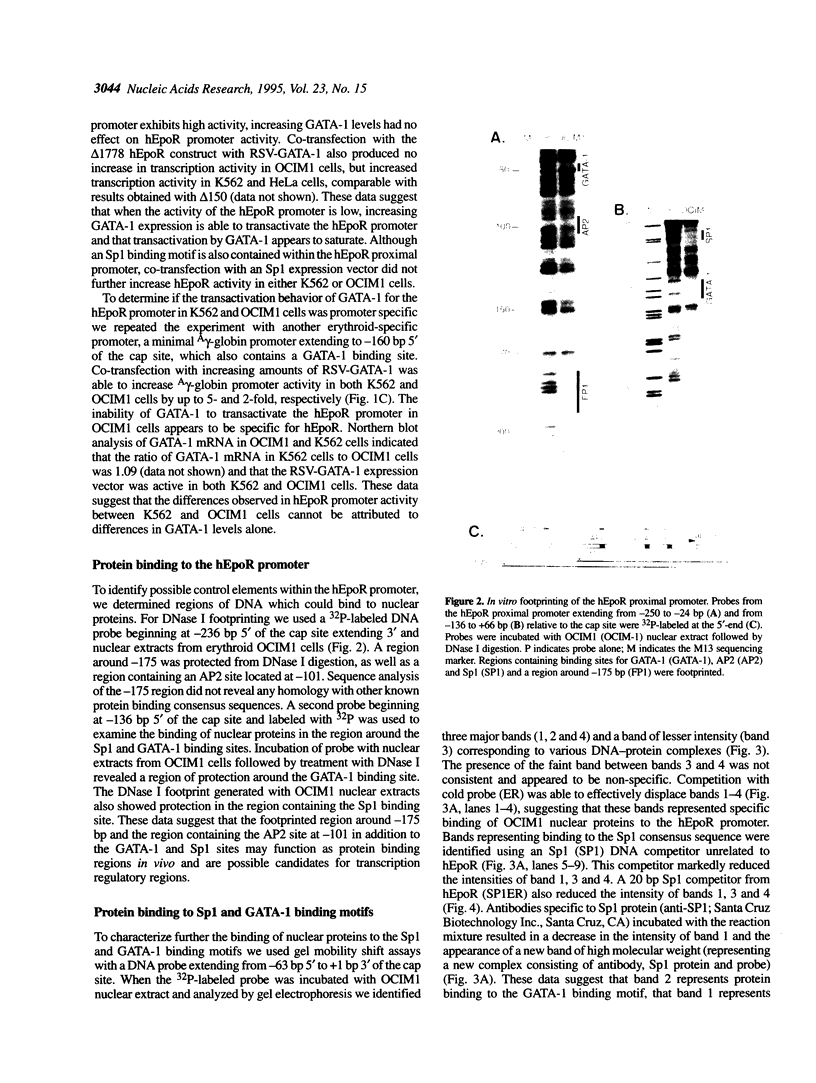
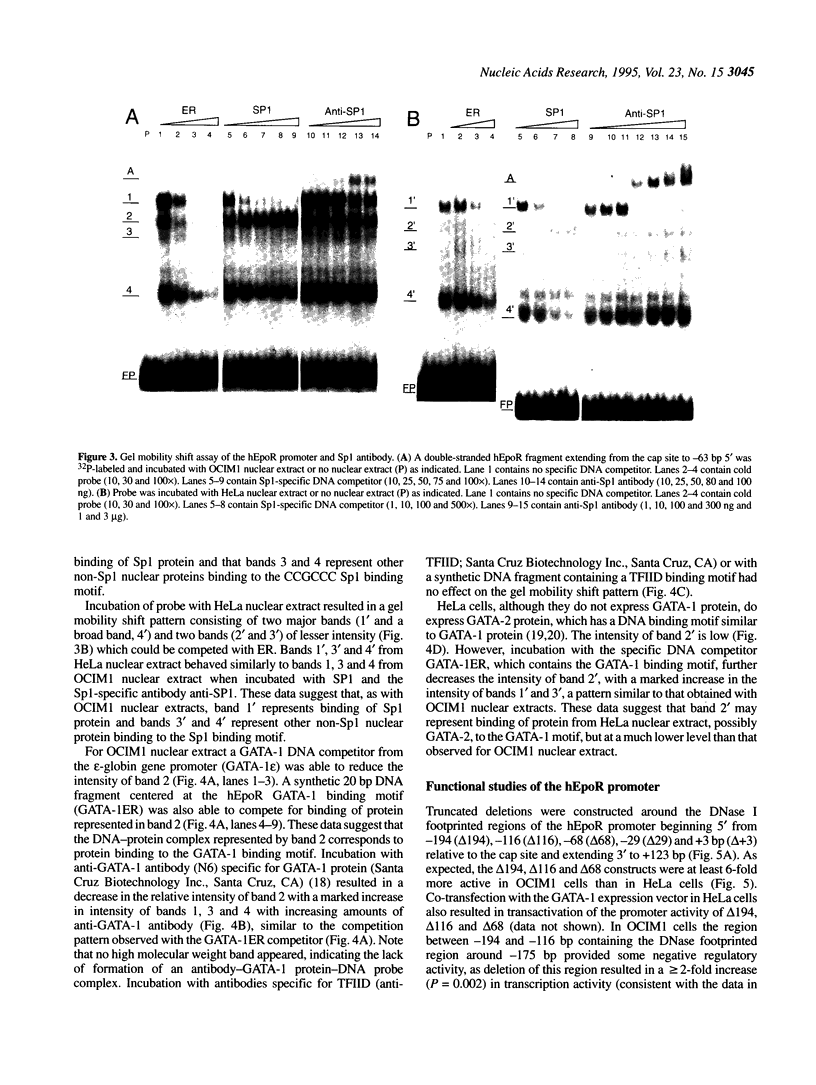
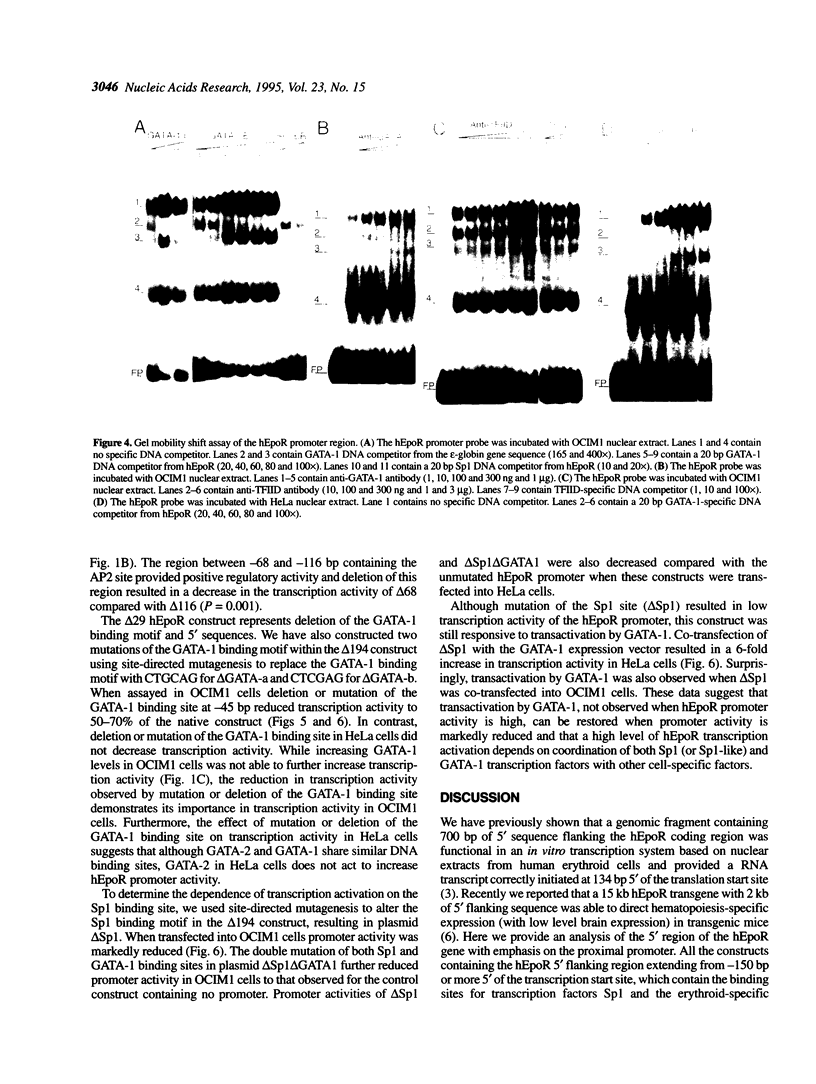
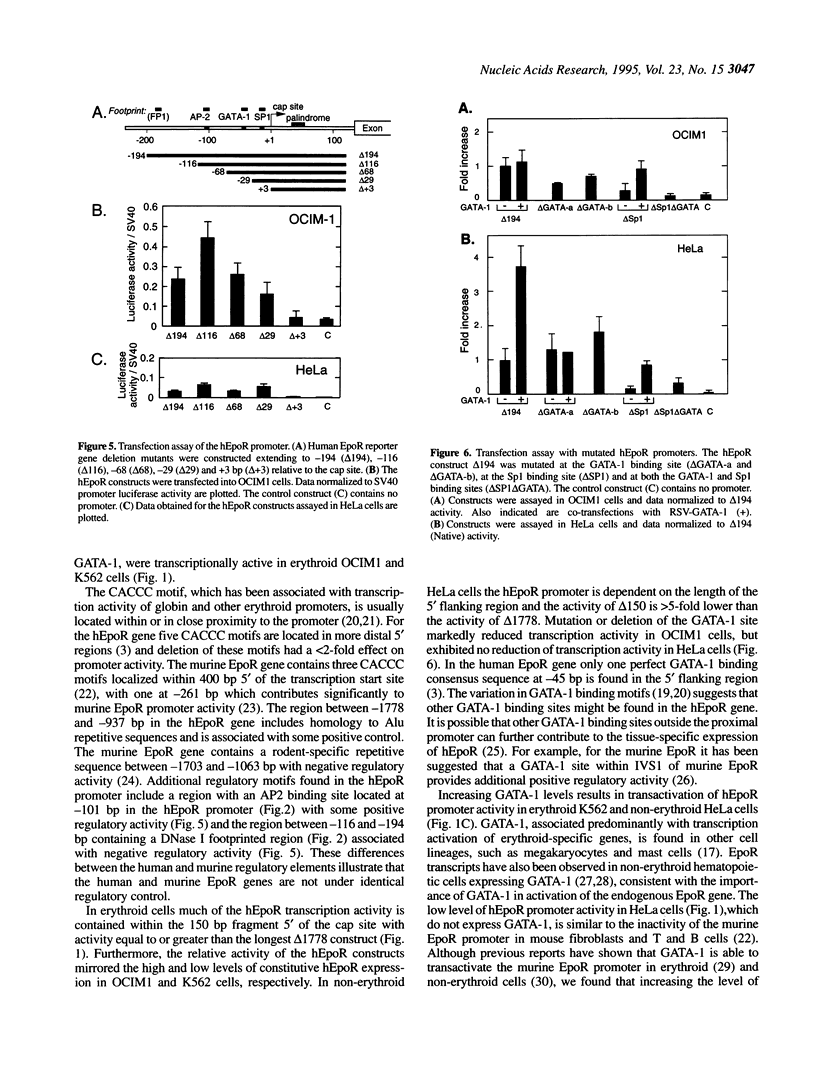
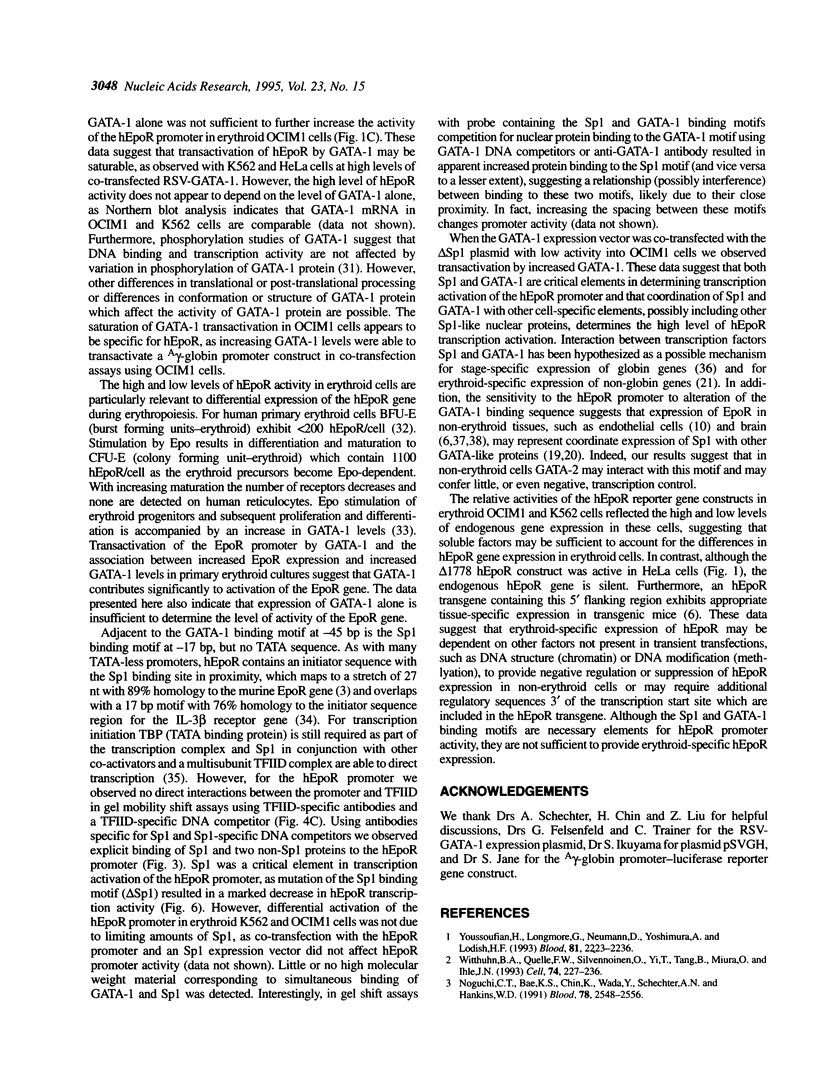
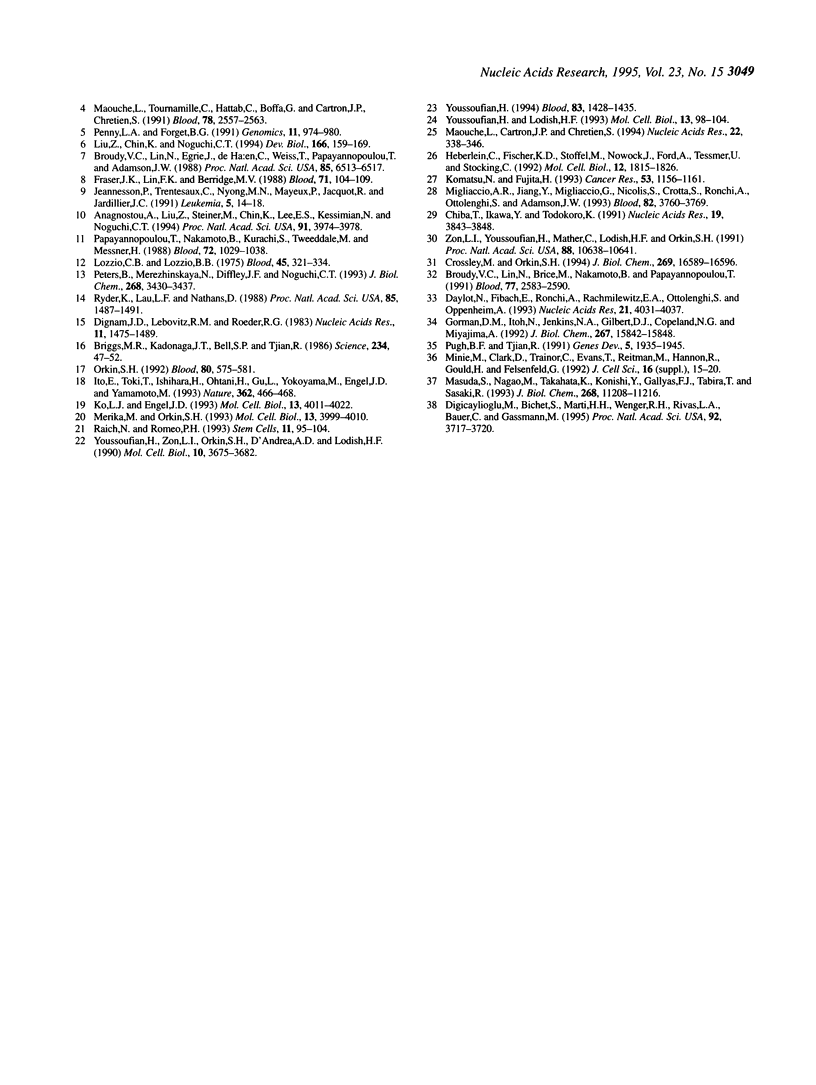
Images in this article
Selected References
These references are in PubMed. This may not be the complete list of references from this article.
- Anagnostou A., Liu Z., Steiner M., Chin K., Lee E. S., Kessimian N., Noguchi C. T. Erythropoietin receptor mRNA expression in human endothelial cells. Proc Natl Acad Sci U S A. 1994 Apr 26;91(9):3974–3978. doi: 10.1073/pnas.91.9.3974. [DOI] [PMC free article] [PubMed] [Google Scholar]
- Briggs M. R., Kadonaga J. T., Bell S. P., Tjian R. Purification and biochemical characterization of the promoter-specific transcription factor, Sp1. Science. 1986 Oct 3;234(4772):47–52. doi: 10.1126/science.3529394. [DOI] [PubMed] [Google Scholar]
- Broudy V. C., Lin N., Brice M., Nakamoto B., Papayannopoulou T. Erythropoietin receptor characteristics on primary human erythroid cells. Blood. 1991 Jun 15;77(12):2583–2590. [PubMed] [Google Scholar]
- Broudy V. C., Lin N., Egrie J., de Haën C., Weiss T., Papayannopoulou T., Adamson J. W. Identification of the receptor for erythropoietin on human and murine erythroleukemia cells and modulation by phorbol ester and dimethyl sulfoxide. Proc Natl Acad Sci U S A. 1988 Sep;85(17):6513–6517. doi: 10.1073/pnas.85.17.6513. [DOI] [PMC free article] [PubMed] [Google Scholar]
- Chiba T., Ikawa Y., Todokoro K. GATA-1 transactivates erythropoietin receptor gene, and erythropoietin receptor-mediated signals enhance GATA-1 gene expression. Nucleic Acids Res. 1991 Jul 25;19(14):3843–3848. doi: 10.1093/nar/19.14.3843. [DOI] [PMC free article] [PubMed] [Google Scholar]
- Crossley M., Orkin S. H. Phosphorylation of the erythroid transcription factor GATA-1. J Biol Chem. 1994 Jun 17;269(24):16589–16596. [PubMed] [Google Scholar]
- Dalyot N., Fibach E., Ronchi A., Rachmilewitz E. A., Ottolenghi S., Oppenheim A. Erythropoietin triggers a burst of GATA-1 in normal human erythroid cells differentiating in tissue culture. Nucleic Acids Res. 1993 Aug 25;21(17):4031–4037. doi: 10.1093/nar/21.17.4031. [DOI] [PMC free article] [PubMed] [Google Scholar]
- Digicaylioglu M., Bichet S., Marti H. H., Wenger R. H., Rivas L. A., Bauer C., Gassmann M. Localization of specific erythropoietin binding sites in defined areas of the mouse brain. Proc Natl Acad Sci U S A. 1995 Apr 25;92(9):3717–3720. doi: 10.1073/pnas.92.9.3717. [DOI] [PMC free article] [PubMed] [Google Scholar]
- Dignam J. D., Lebovitz R. M., Roeder R. G. Accurate transcription initiation by RNA polymerase II in a soluble extract from isolated mammalian nuclei. Nucleic Acids Res. 1983 Mar 11;11(5):1475–1489. doi: 10.1093/nar/11.5.1475. [DOI] [PMC free article] [PubMed] [Google Scholar]
- Fraser J. K., Lin F. K., Berridge M. V. Expression and modulation of specific, high affinity binding sites for erythropoietin on the human erythroleukemic cell line K562. Blood. 1988 Jan;71(1):104–109. [PubMed] [Google Scholar]
- Gorman D. M., Itoh N., Jenkins N. A., Gilbert D. J., Copeland N. G., Miyajima A. Chromosomal localization and organization of the murine genes encoding the beta subunits (AIC2A and AIC2B) of the interleukin 3, granulocyte/macrophage colony-stimulating factor, and interleukin 5 receptors. J Biol Chem. 1992 Aug 5;267(22):15842–15848. [PubMed] [Google Scholar]
- Heberlein C., Fischer K. D., Stoffel M., Nowock J., Ford A., Tessmer U., Stocking C. The gene for erythropoietin receptor is expressed in multipotential hematopoietic and embryonal stem cells: evidence for differentiation stage-specific regulation. Mol Cell Biol. 1992 Apr;12(4):1815–1826. doi: 10.1128/mcb.12.4.1815. [DOI] [PMC free article] [PubMed] [Google Scholar]
- Ito E., Toki T., Ishihara H., Ohtani H., Gu L., Yokoyama M., Engel J. D., Yamamoto M. Erythroid transcription factor GATA-1 is abundantly transcribed in mouse testis. Nature. 1993 Apr 1;362(6419):466–468. doi: 10.1038/362466a0. [DOI] [PubMed] [Google Scholar]
- Jeannesson P., Trentesaux C., Nyoung M. N., Mayeux P., Jacquot R., Jardillier J. C. Induction of erythropoietin receptors during aclacinomycin-mediated erythroid differentiation of K562 leukemia cells. Leukemia. 1991 Jan;5(1):14–18. [PubMed] [Google Scholar]
- Ko L. J., Engel J. D. DNA-binding specificities of the GATA transcription factor family. Mol Cell Biol. 1993 Jul;13(7):4011–4022. doi: 10.1128/mcb.13.7.4011. [DOI] [PMC free article] [PubMed] [Google Scholar]
- Komatsu N., Fujita H. Induced megakaryocytic maturation of the human leukemia cell line UT-7 results in down-modulation of erythropoietin receptor gene expression. Cancer Res. 1993 Mar 1;53(5):1156–1161. [PubMed] [Google Scholar]
- Liu Z. Y., Chin K., Noguchi C. T. Tissue specific expression of human erythropoietin receptor in transgenic mice. Dev Biol. 1994 Nov;166(1):159–169. doi: 10.1006/dbio.1994.1304. [DOI] [PubMed] [Google Scholar]
- Lozzio C. B., Lozzio B. B. Human chronic myelogenous leukemia cell-line with positive Philadelphia chromosome. Blood. 1975 Mar;45(3):321–334. [PubMed] [Google Scholar]
- Maouche L., Cartron J. P., Chretien S. Different domains regulate the human erythropoietin receptor gene transcription. Nucleic Acids Res. 1994 Feb 11;22(3):338–346. doi: 10.1093/nar/22.3.338. [DOI] [PMC free article] [PubMed] [Google Scholar]
- Maouche L., Tournamille C., Hattab C., Boffa G., Cartron J. P., Chrétien S. Cloning of the gene encoding the human erythropoietin receptor. Blood. 1991 Nov 15;78(10):2557–2563. [PubMed] [Google Scholar]
- Masuda S., Nagao M., Takahata K., Konishi Y., Gallyas F., Jr, Tabira T., Sasaki R. Functional erythropoietin receptor of the cells with neural characteristics. Comparison with receptor properties of erythroid cells. J Biol Chem. 1993 May 25;268(15):11208–11216. [PubMed] [Google Scholar]
- Merika M., Orkin S. H. DNA-binding specificity of GATA family transcription factors. Mol Cell Biol. 1993 Jul;13(7):3999–4010. doi: 10.1128/mcb.13.7.3999. [DOI] [PMC free article] [PubMed] [Google Scholar]
- Migliaccio A. R., Jiang Y., Migliaccio G., Nicolis S., Crotta S., Ronchi A., Ottolenghi S., Adamson J. W. Transcriptional and posttranscriptional regulation of the expression of the erythropoietin receptor gene in human erythropoietin-responsive cell lines. Blood. 1993 Dec 15;82(12):3760–3769. [PubMed] [Google Scholar]
- Minie M., Clark D., Trainor C., Evans T., Reitman M., Hannon R., Gould H., Felsenfeld G. Developmental regulation of globin gene expression. J Cell Sci Suppl. 1992;16:15–20. doi: 10.1242/jcs.1992.supplement_16.3. [DOI] [PubMed] [Google Scholar]
- Noguchi C. T., Bae K. S., Chin K., Wada Y., Schechter A. N., Hankins W. D. Cloning of the human erythropoietin receptor gene. Blood. 1991 Nov 15;78(10):2548–2556. [PubMed] [Google Scholar]
- Orkin S. H. GATA-binding transcription factors in hematopoietic cells. Blood. 1992 Aug 1;80(3):575–581. [PubMed] [Google Scholar]
- Papayannopoulou T., Nakamoto B., Kurachi S., Tweeddale M., Messner H. Surface antigenic profile and globin phenotype of two new human erythroleukemia lines: characterization and interpretations. Blood. 1988 Sep;72(3):1029–1038. [PubMed] [Google Scholar]
- Penny L. A., Forget B. G. Genomic organization of the human erythropoietin receptor gene. Genomics. 1991 Dec;11(4):974–980. doi: 10.1016/0888-7543(91)90022-7. [DOI] [PubMed] [Google Scholar]
- Peters B., Merezhinskaya N., Diffley J. F., Noguchi C. T. Protein-DNA interactions in the epsilon-globin gene silencer. J Biol Chem. 1993 Feb 15;268(5):3430–3437. [PubMed] [Google Scholar]
- Pugh B. F., Tjian R. Transcription from a TATA-less promoter requires a multisubunit TFIID complex. Genes Dev. 1991 Nov;5(11):1935–1945. doi: 10.1101/gad.5.11.1935. [DOI] [PubMed] [Google Scholar]
- Raich N., Romeo P. H. Erythroid regulatory elements. Stem Cells. 1993 Mar;11(2):95–104. doi: 10.1002/stem.5530110204. [DOI] [PubMed] [Google Scholar]
- Ryder K., Lau L. F., Nathans D. A gene activated by growth factors is related to the oncogene v-jun. Proc Natl Acad Sci U S A. 1988 Mar;85(5):1487–1491. doi: 10.1073/pnas.85.5.1487. [DOI] [PMC free article] [PubMed] [Google Scholar]
- Witthuhn B. A., Quelle F. W., Silvennoinen O., Yi T., Tang B., Miura O., Ihle J. N. JAK2 associates with the erythropoietin receptor and is tyrosine phosphorylated and activated following stimulation with erythropoietin. Cell. 1993 Jul 30;74(2):227–236. doi: 10.1016/0092-8674(93)90414-l. [DOI] [PubMed] [Google Scholar]
- Youssoufian H. Further characterization of cis-acting regulatory sequences in the genomic locus of the murine erythropoietin receptor: evidence for stage-specific regulation. Blood. 1994 Mar 1;83(5):1428–1435. [PubMed] [Google Scholar]
- Youssoufian H., Lodish H. F. Transcriptional inhibition of the murine erythropoietin receptor gene by an upstream repetitive element. Mol Cell Biol. 1993 Jan;13(1):98–104. doi: 10.1128/mcb.13.1.98. [DOI] [PMC free article] [PubMed] [Google Scholar]
- Youssoufian H., Longmore G., Neumann D., Yoshimura A., Lodish H. F. Structure, function, and activation of the erythropoietin receptor. Blood. 1993 May 1;81(9):2223–2236. [PubMed] [Google Scholar]
- Youssoufian H., Zon L. I., Orkin S. H., D'Andrea A. D., Lodish H. F. Structure and transcription of the mouse erythropoietin receptor gene. Mol Cell Biol. 1990 Jul;10(7):3675–3682. doi: 10.1128/mcb.10.7.3675. [DOI] [PMC free article] [PubMed] [Google Scholar]
- Zon L. I., Youssoufian H., Mather C., Lodish H. F., Orkin S. H. Activation of the erythropoietin receptor promoter by transcription factor GATA-1. Proc Natl Acad Sci U S A. 1991 Dec 1;88(23):10638–10641. doi: 10.1073/pnas.88.23.10638. [DOI] [PMC free article] [PubMed] [Google Scholar]



